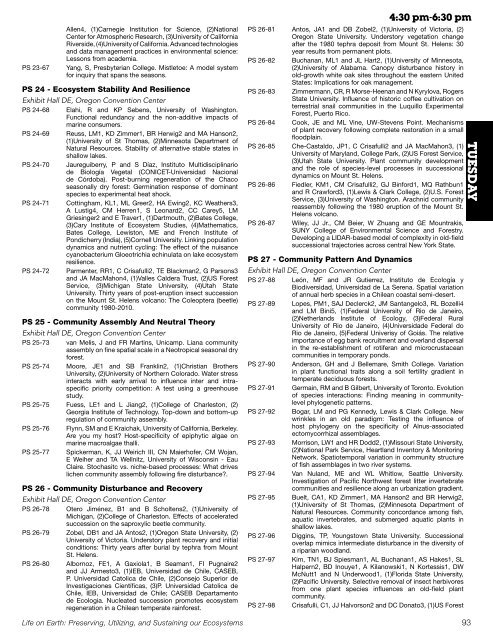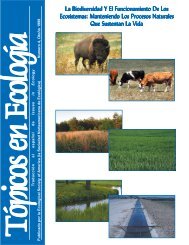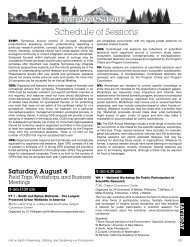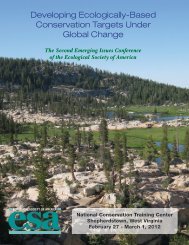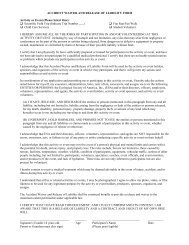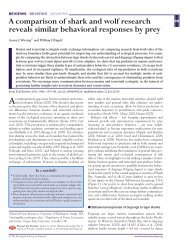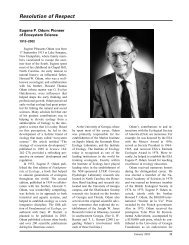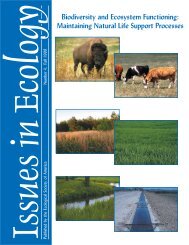Printed Program (PDF) - Ecological Society of America
Printed Program (PDF) - Ecological Society of America
Printed Program (PDF) - Ecological Society of America
Create successful ePaper yourself
Turn your PDF publications into a flip-book with our unique Google optimized e-Paper software.
Allen4, (1)Carnegie Institution for Science, (2)National<br />
Center for Atmospheric Research, (3)University <strong>of</strong> California<br />
Riverside, (4)University <strong>of</strong> California. Advanced technologies<br />
and data management practices in environmental science:<br />
Lessons from academia.<br />
PS 23-67 Yang, S, Presbyterian College. Mistletoe: A model system<br />
for inquiry that spans the seasons.<br />
PS 24 - Ecosystem Stability And Resilience<br />
Exhibit Hall DE, Oregon Convention Center<br />
PS 24-68 Elahi, R and KP Sebens, University <strong>of</strong> Washington.<br />
Functional redundancy and the non-additive impacts <strong>of</strong><br />
marine consumers.<br />
PS 24-69 Reuss, LM1, KD Zimmer1, BR Herwig2 and MA Hanson2,<br />
(1)University <strong>of</strong> St Thomas, (2)Minnesota Department <strong>of</strong><br />
Natural Resources. Stability <strong>of</strong> alternative stable states in<br />
shallow lakes.<br />
PS 24-70 Jaureguiberry, P and S Díaz, Instituto Multidisciplinario<br />
de Biología Vegetal (CONICET-Universidad Nacional<br />
de Córdoba). Post-burning regeneration <strong>of</strong> the Chaco<br />
seasonally dry forest: Germination response <strong>of</strong> dominant<br />
species to experimental heat shock.<br />
PS 24-71 Cottingham, KL1, ML Greer2, HA Ewing2, KC Weathers3,<br />
A Lustig4, CM Herren1, S Leonard2, CC Carey5, LM<br />
Griesinger2 and E Traver1, (1)Dartmouth, (2)Bates College,<br />
(3)Cary Institute <strong>of</strong> Ecosystem Studies, (4)Mathematics,<br />
Bates College, Lewiston, ME and French Institute <strong>of</strong><br />
Pondicherry (India), (5)Cornell University. Linking population<br />
dynamics and nutrient cycling: The effect <strong>of</strong> the nuisance<br />
cyanobacterium Gloeotrichia echinulata on lake ecosystem<br />
resilience.<br />
PS 24-72 Parmenter, RR1, C Crisafulli2, TE Blackman2, G Parsons3<br />
and JA MacMahon4, (1)Valles Caldera Trust, (2)US Forest<br />
Service, (3)Michigan State University, (4)Utah State<br />
University. Thirty years <strong>of</strong> post-eruption insect succession<br />
on the Mount St. Helens volcano: The Coleoptera (beetle)<br />
community 1980-2010.<br />
PS 25 - Community Assembly And Neutral Theory<br />
Exhibit Hall DE, Oregon Convention Center<br />
PS 25-73 van Melis, J and FR Martins, Unicamp. Liana community<br />
assembly on fine spatial scale in a Neotropical seasonal dry<br />
forest.<br />
PS 25-74 Moore, JE1 and SB Franklin2, (1)Christian Brothers<br />
University, (2)University <strong>of</strong> Northern Colorado. Water stress<br />
interacts with early arrival to influence inter and intraspecific<br />
priority competition: A test using a greenhouse<br />
study.<br />
PS 25-75 Fuess, LE1 and L Jiang2, (1)College <strong>of</strong> Charleston, (2)<br />
Georgia Institute <strong>of</strong> Technology. Top-down and bottom-up<br />
regulation <strong>of</strong> community assembly.<br />
PS 25-76 Flynn, SM and E Kraichak, University <strong>of</strong> California, Berkeley.<br />
Are you my host? Host-specificity <strong>of</strong> epiphytic algae on<br />
marine macroalgae thalli.<br />
PS 25-77 Spickerman, K, JJ Weirich III, CN Maierh<strong>of</strong>er, CM Wojan,<br />
E Weiher and TA Wellnitz, University <strong>of</strong> Wisconsin - Eau<br />
Claire. Stochasitc vs. niche-based processes: What drives<br />
lichen community assembly following fire disturbance?.<br />
PS 26 - Community Disturbance and Recovery<br />
Exhibit Hall DE, Oregon Convention Center<br />
PS 26-78 Otero Jiménez, B1 and B Scholtens2, (1)University <strong>of</strong><br />
Michigan, (2)College <strong>of</strong> Charleston. Effects <strong>of</strong> accelerated<br />
succession on the saproxylic beetle community.<br />
PS 26-79 Zobel, DB1 and JA Antos2, (1)Oregon State University, (2)<br />
University <strong>of</strong> Victoria. Understory plant recovery and initial<br />
conditions: Thirty years after burial by tephra from Mount<br />
St. Helens.<br />
PS 26-80 Albornoz, FE1, A Gaxiola1, B Seaman1, FI Pugnaire2<br />
and JJ Armesto3, (1)IEB, Universidad de Chile, CASEB,<br />
P. Universidad Catolica de Chile, (2)Consejo Superior de<br />
Investigaciones Científicas, (3)P. Universidad Catolica de<br />
Chile, IEB, Universidad de Chile; CASEB Departamento<br />
de Ecologia. Nucleated succession promotes ecosystem<br />
regeneration in a Chilean temperate rainforest.<br />
Life on Earth: Preserving, Utilizing, and Sustaining our Ecosystems<br />
4:30 pm-6:30 pm<br />
PS 26-81 Antos, JA1 and DB Zobel2, (1)University <strong>of</strong> Victoria, (2)<br />
Oregon State University. Understory vegetation change<br />
after the 1980 tephra deposit from Mount St. Helens: 30<br />
year results from permanent plots.<br />
PS 26-82 Buchanan, ML1 and JL Hart2, (1)University <strong>of</strong> Minnesota,<br />
(2)University <strong>of</strong> Alabama. Canopy disturbance history in<br />
old-growth white oak sites throughout the eastern United<br />
States: Implications for oak management.<br />
PS 26-83 Zimmermann, CR, R Morse-Heenan and N Kyrylova, Rogers<br />
State University. Influence <strong>of</strong> historic c<strong>of</strong>fee cultivation on<br />
terrestrial snail communities in the Luquillo Experimental<br />
Forest, Puerto Rico.<br />
PS 26-84 Cook, JE and ML Vine, UW-Stevens Point. Mechanisms<br />
<strong>of</strong> plant recovery following complete restoration in a small<br />
floodplain.<br />
PS 26-85 Che-Castaldo, JP1, C Crisafulli2 and JA MacMahon3, (1)<br />
University <strong>of</strong> Maryland, College Park, (2)US Forest Service,<br />
(3)Utah State University. Plant community development<br />
and the role <strong>of</strong> species-level processes in successional<br />
dynamics on Mount St. Helens.<br />
PS 26-86 Fiedler, KM1, CM Crisafulli2, GJ Binford1, MQ Rathbun1<br />
and R Crawford3, (1)Lewis & Clark College, (2)U.S. Forest<br />
Service, (3)University <strong>of</strong> Washington. Arachnid community<br />
reassembly following the 1980 eruption <strong>of</strong> the Mount St.<br />
Helens volcano.<br />
PS 26-87 Wiley, JJ Jr., CM Beier, W Zhuang and GE Mountrakis,<br />
SUNY College <strong>of</strong> Environmental Science and Forestry.<br />
Developing a LIDAR-based model <strong>of</strong> complexity in old-field<br />
successional trajectories across central New York State.<br />
PS 27 - Community Pattern And Dynamics<br />
Exhibit Hall DE, Oregon Convention Center<br />
PS 27-88 León, MF and JR Gutierrez, Instituto de Ecología y<br />
Biodiversidad, Universidad de La Serena. Spatial variation<br />
<strong>of</strong> annual herb species in a Chilean coastal semi-desert.<br />
PS 27-89 Lopes, PM1, SAJ Declerck2, JM Santangelo3, RL Bozelli4<br />
and LM Bini5, (1)Federal University <strong>of</strong> Rio de Janeiro,<br />
(2)Netherlands Institute <strong>of</strong> Ecology, (3)Federal Rural<br />
University <strong>of</strong> Rio de Janeiro, (4)Universidade Federal do<br />
Rio de Janeiro, (5)Federal Univerisy <strong>of</strong> Goiás. The relative<br />
importance <strong>of</strong> egg bank recruitment and overland dispersal<br />
in the re-establishment <strong>of</strong> rotiferan and microcrustacean<br />
communities in temporary ponds.<br />
PS 27-90 Anderson, GH and J Bellemare, Smith College. Variation<br />
in plant functional traits along a soil fertility gradient in<br />
temperate deciduous forests.<br />
PS 27-91 Germain, RM and B Gilbert, University <strong>of</strong> Toronto. Evolution<br />
<strong>of</strong> species interactions: Finding meaning in communitylevel<br />
phylogenetic patterns.<br />
PS 27-92 Bogar, LM and PG Kennedy, Lewis & Clark College. New<br />
wrinkles in an old paradigm: Testing the influence <strong>of</strong><br />
host phylogeny on the specificity <strong>of</strong> Alnus-associated<br />
ectomycorrhizal assemblages.<br />
PS 27-93 Morrison, LW1 and HR Dodd2, (1)Missouri State University,<br />
(2)National Park Service, Heartland Inventory & Monitoring<br />
Network. Spatiotemporal variation in community structure<br />
<strong>of</strong> fish assemblages in two river systems.<br />
PS 27-94 Van Nuland, ME and WL Whitlow, Seattle University.<br />
Investigation <strong>of</strong> Pacific Northwest forest litter invertebrate<br />
communities and resilience along an urbanization gradient.<br />
PS 27-95 Buelt, CA1, KD Zimmer1, MA Hanson2 and BR Herwig2,<br />
(1)University <strong>of</strong> St Thomas, (2)Minnesota Department <strong>of</strong><br />
Natural Resources. Community concordance among fish,<br />
aquatic invertebrates, and submerged aquatic plants in<br />
shallow lakes.<br />
PS 27-96 Diggins, TP, Youngstown State University. Successional<br />
overlap mimics intermediate disturbance in the diversity <strong>of</strong><br />
a riparian woodland.<br />
PS 27-97 Kim, TN1, BJ Spiesman1, AL Buchanan1, AS Hakes1, SL<br />
Halpern2, BD Inouye1, A Kilanowski1, N Kortessis1, DW<br />
McNutt1 and N Underwood1, (1)Florida State University,<br />
(2)Pacific University. Selective removal <strong>of</strong> insect herbivores<br />
from one plant species influences an old-field plant<br />
community.<br />
PS 27-98 Crisafulli, C1, JJ Halvorson2 and DC Donato3, (1)US Forest<br />
TUESDAY<br />
93


